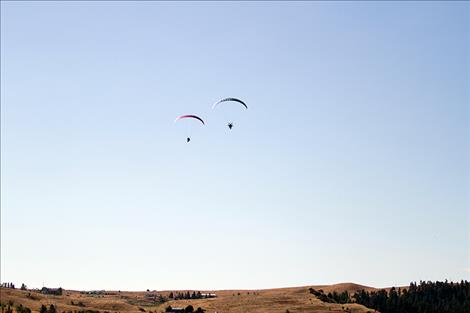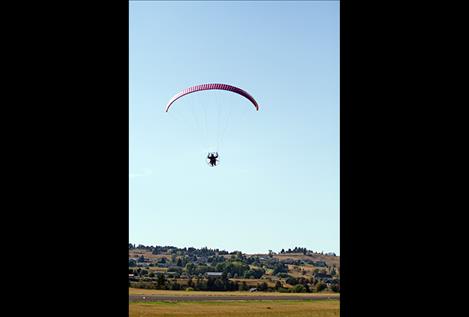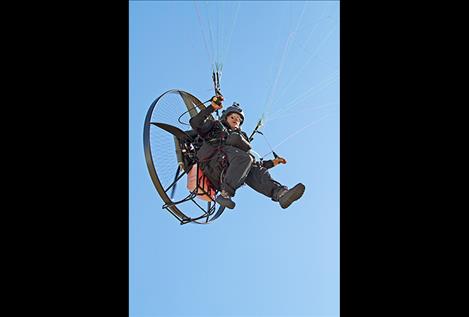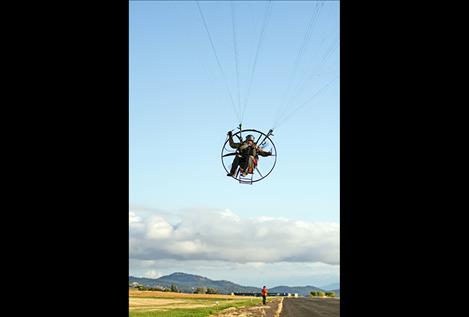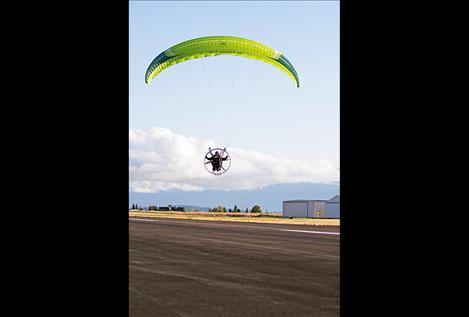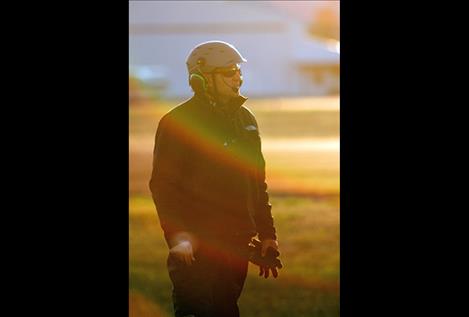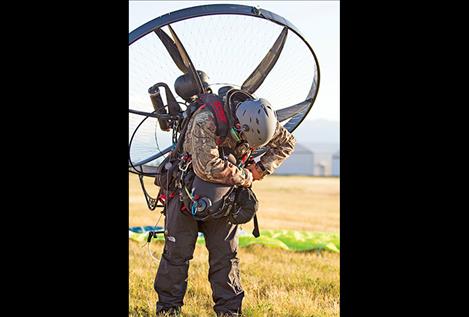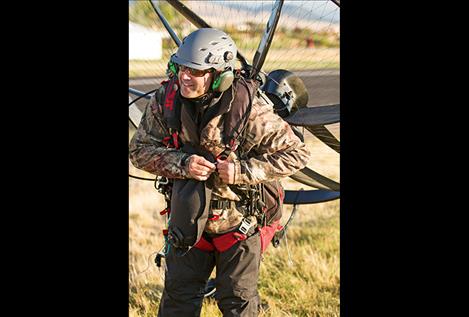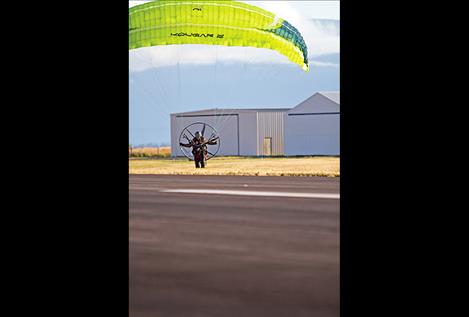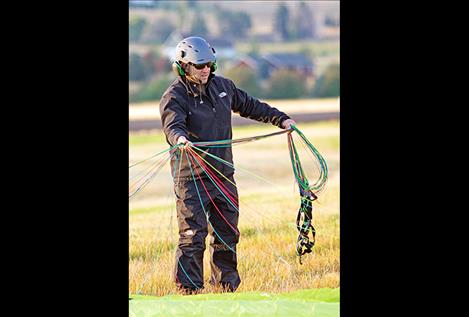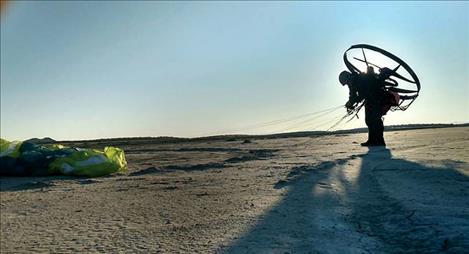Polson man flies over mountains, desert in 1,000 mile adventure
Hey savvy news reader! Thanks for choosing local.
You are now reading
1 of 3 free articles.
POLSON – Over the past week and a half, Polson resident Jack Nordberg and seven other adventurous aviators embarked on a grueling cross-country paramotor race known as the Icarus Trophy.
Billed as the “toughest air race in the world” by the race organizers, the Icarus Trophy is a near 1,000-mile test of ultimate endurance and pilot skill. The race started in Polson on Sept. 24 and concluded with an awards ceremony and party on Oct. 5 in Mesquite, Nevada.
The Adventurists, a British based adventure group, organizes the Icarus Trophy along with several other extreme adventure activities such as a sidecar motorcycle rally across Siberia’s frozen Lake Baikal, a car rally through the Gobi Desert, an 1,800-mile rickshaw run through India, a 600-mile horse derby across Genghis Khan’s legendary Mongolia empire and a race across the Indian Ocean with a dugout canoe made from a mango tree.
“I started a little over a year ago,” Mission Valley paramotorist Jack Nordberg said. “A friend of mine, Canyon Hansen, got me into paramotoring last year when he buzzed right over my head while I was working. I couldn’t believe that a paper-thin fabric wing and tiny lines could do that! I thought it was more like a hot air balloon ride until I saw that.”
In paramotoring, the pilot wears a framed backpack outfitted with a two-stroke piston engine, which drives a carbon fiber two or three-blade propeller to produce thrust. A parachute-like wing made from ripstop fabric, a durable and near-tear-proof nylon, is connected by lines to a body harness worn by the pilot.
Flight is achieved when the pilot trails the wing behind them like a kite, then revs the engine and sprints a short distance until the forward momentum inflates the wing cells generating lift.
Watching this visually striking and extreme activity, to most for the first time, may look like a certifiable crazy thing to do.
According to the United States Powered Paragliding Association, powered paragliding (aka paramotoring) is one of the simplest and safest forms of flight. The wing and paramotor set up and break down in minutes and can fit in the bed of a pickup truck or in the trunk of a car. If the motor quits, the glider allows a pilot to descend altitude at an approximate rate of 3 mph over a 20 foot glide. “A motor failure is rarely more than an inconvenience,” the USPPA website states.
“The best part of paramotoring is the freedom to go anywhere you want,” Nordberg said. “Soaring 12,000 feet above the Missions, looking down on a heard of elk or just buzzing a couple feet off the ground.”
Nordberg also mentioned the adrenaline rush and the G-force induced tunnel vision he receives from performing aerial stunts like wing overs and barrel rolls always leaves him walking away shaking head saying, “holy shit that was cool.”
With just a few gallons of ordinary gasoline, a person can fly for hours, go anywhere, land anywhere, buzz inches above the ground or ascend thousands of feet into the clouds.
As adventures go, paramotoring is as extreme as the person flying wishes to make it. The Icarus Trophy however, ramps up the extreme quotient 100 percent by adding 10,000-foot peaks, remote canyons, unforgiving deserts, and the physical and mental exhaustion that comes with flying days on end in adverse wind and weather conditions.
Icarus pilots can register to race in one of two race classes: the race division or adventure division. According to the Icarus Trophy website, race division pilots must fly unsupported and be first to the finish line to win. “Pilots must remain unsupported for the entire event - they can only progress by flying or walking. If they walk, they must carry their equipment,” the official rules state. “They can use ‘open access’ support – anything that the average person can access. Should they manage to charm total strangers into lending their assistance, that’s kosher. They cannot use help offered by friends, distant relatives, other pilots or the race team to further their progress.”
Adventure division pilots are permitted to enlist help from ground crews, friends, family, locals, even Uber drivers if they get stuck somewhere and can’t fly out.
After days of constant pressure to join the Icarus race from his paramotor mentor and training partner Canyon Hansen, Nordberg finally succumbed and registered for the adventure class just weeks before the start of the race.
“I joined the adventure race because it is the last time it will be here in Polson and I figured I better jump on it since it will be a once in a lifetime opportunity,” Nordberg said. “Flying through Moab and the monster huge rock pillars and mesas in Monument Valley, maybe landing on top of one and getting a view very people in the world will ever see. Foot dragging on the Bonneville salt flats. It sounds super fun! Why would you not get in this race?”
Upon completion of the first leg of the race, Nordberg had second thoughts about his decision. “What the hell did he get me into?” Nordberg said. “But I can’t thank him enough for pushing me to do it. By the end of the race I learned a lot about myself, flying in different conditions and it turned out to be an
Amazing, unforgettable experience.”
Nordberg was hard pressed to pick a part of his trip that stood out above others. “Every flight was memorable,” he said. “Flying over the Pintlar Mountains near Anaconda was quite memorable. There was fresh snow on the ground and it was about 32 degrees when I took off around 7 in the morning. I was flying about 10,000 feet because I had a good tail wind. It was extremely cold. I saw some elk in the mountains and that was pretty cool. The best flight had to be flying Monument Valley, all the big rock formations and wide-open space was amazing. The Bonneville Salt Flats was impressive to see from the air. I had planned to do a foot drag through the sand and water, but the weather wasn’t cooperative.”
Nordberg hasn’t decided yet if he will compete in the Icarus race next year or not. “I guess it depends on where the race will be held,” Nordberg said. “If I decide to compete in it next year, I would probably dothe race class.”
In the meantime, Nordberg will enjoy his memories and Spirit of Adventure Award. Nordberg was given the award “for being the pilot who battled the odds and yet still came out smiling,” according to the official Icarus Trophy website.















